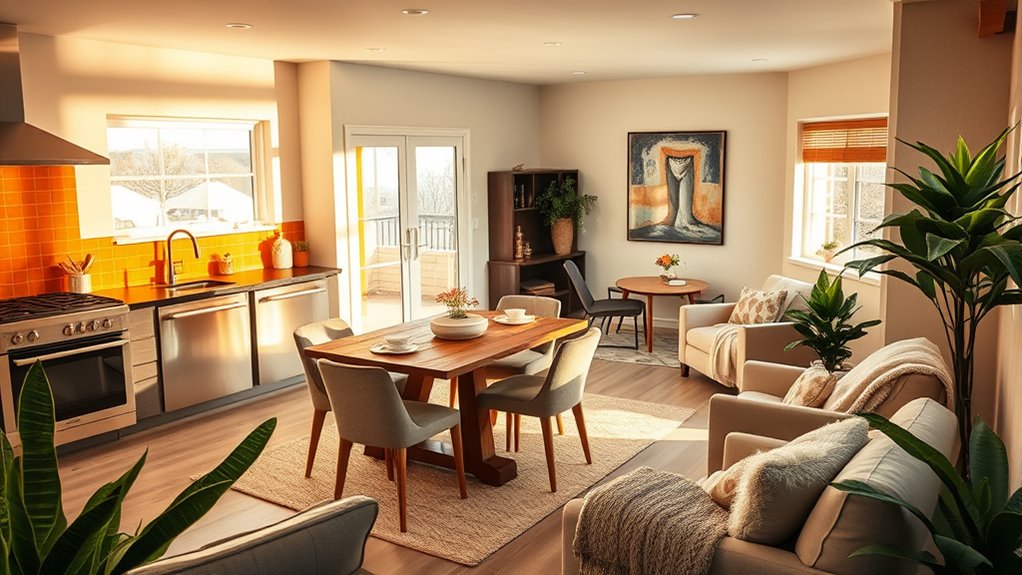To create functional zones for cooking, dining, and relaxation, visualize the space flow and layout to guarantee harmony among areas. Arrange furniture, lighting, and decor that support each zone’s purpose, making sure movement is smooth. Use textiles and personal touches to add warmth and cohesion. Keep clutter out of sight with smart storage, and position key appliances thoughtfully. To find out how to refine each zone for maximum enjoyment, keep exploring the tips below.
Key Takeaways
- Visualize space flow to define distinct zones for cooking, dining, and relaxation, ensuring harmony and functional movement.
- Arrange furniture and appliances to optimize the work triangle in the kitchen for safety and efficiency.
- Position the dining table for easy access from the kitchen, allowing comfortable movement and creating an inviting atmosphere.
- Design the relaxation area with cozy seating, rugs, and soft lighting to foster comfort and personalization.
- Incorporate textiles and decor elements that unify zones visually while enhancing ambiance and aesthetic appeal.

Have you ever wondered how to organize your space effectively? Creating distinct zones within your home can make your daily routines more enjoyable and functional. Start by visualizing the flow of your space and identifying areas for cooking, dining, and relaxation. The key is to design each zone thoughtfully, considering both lighting ambiance and furniture arrangement. These elements influence how you experience each space, ensuring they serve their specific purpose while harmonizing with the overall layout. Incorporating rustic textiles such as farmhouse tablecloths or dish towels can also enhance the cozy atmosphere and tie the zones together visually.
Creating distinct zones enhances your home’s flow and functionality through thoughtful design and lighting.
For your cooking zone, prioritize functionality and safety. Arrange your appliances and work surfaces to minimize unnecessary movement. Keep the stove, sink, and refrigerator within easy reach to create a practical work triangle. Lighting should be bright and focused here, so opt for task lighting like under-cabinet lights or pendant fixtures that illuminate your countertops. This not only enhances visibility but also adds a stylish touch to the space. When arranging furniture in the kitchen, choose pieces that don’t clutter the area; a compact island or a small table can provide extra prep space without overwhelming the room.
Moving to your dining zone, comfort and ambiance are paramount. Position your dining table where it’s easily accessible from the kitchen but still offers a sense of intimacy. Consider the furniture arrangement carefully—leave enough space around the table for chairs to be pulled out comfortably. For lighting ambiance, a statement chandelier or pendant light above the table creates a warm, inviting atmosphere. Dimmers can be a great addition, allowing you to adjust the lighting based on the occasion. Incorporate a sideboard or buffet if space permits, providing storage and surface area for serving dishes or decorations. The furniture should complement the room’s scale, avoiding overcrowding and fostering easy movement.
In your relaxation zone, comfort takes center stage. Arrange your sofa, chairs, and coffee table to promote conversation and a cozy vibe. Use rugs to define the space and anchor your furniture. Lighting here should be softer—think table lamps, wall sconces, or dimmable fixtures that allow you to set the mood. The lighting ambiance in this zone encourages unwinding and leisure. Keep clutter out of sight with smart storage solutions, creating a calming environment. Plants, artwork, or personal touches can further personalize this area, making it feel like a retreat within your home.
Frequently Asked Questions
How Do I Balance Open Plan and Privacy?
To balance open plan and privacy, you should use privacy solutions like screens, curtains, or sliding doors to create distinct zones. Implement zone differentiation by arranging furniture strategically, such as placing sofas or islands to separate cooking from relaxation areas. This way, you maintain an open feel while providing private spaces when needed, making your home functional and welcoming without sacrificing privacy.
What Lighting Options Suit Different Zones?
You should use ambient lighting to create a warm, inviting atmosphere in your relaxation and dining zones, while task lighting is essential for your cooking area to guarantee safety and precision. Consider dimmable fixtures or layered lighting options to adjust brightness based on activity. Recessed lights, pendant lamps, or under-cabinet lights work well for different zones, helping you balance functionality with ambiance effortlessly.
How Can I Improve Sound Insulation?
To improve sound insulation, you should add soundproofing barriers like acoustic panels or thick curtains around noisy areas. Installing acoustic ceiling tiles helps absorb sound and reduce echo, especially in open spaces. Consider using rugs, upholstered furniture, and draft stoppers on doors to further minimize noise transfer. These steps create a quieter environment, making your zones more comfortable and peaceful.
What Are Space-Saving Furniture Ideas?
Think of your space as a puzzle waiting to be completed. To save room, choose multifunctional furniture like sofa beds or fold-away tables. Incorporate modular storage solutions that adapt to your needs, stacking or sliding out of sight when not in use. These ideas make your home versatile, helping you maximize every inch while keeping it organized and stylish. Your space becomes a flexible canvas for living, working, and relaxing.
How Do I Maintain a Cohesive Design?
To maintain a cohesive design, focus on color harmony and decor consistency throughout your space. Choose a unified color palette and repeat key colors in different areas to tie everything together. Select decor elements that complement each other in style and materials, creating a seamless flow between zones. Avoid clutter and ensure furniture and accessories match the overall theme, helping your space feel harmonious and well-coordinated.
Conclusion
Now that you’ve mastered creating clear, cozy zones, you’ll enjoy effortless elegance in your space. By blending beautiful boundaries with bold basics, you bring balance, beauty, and brilliance to your home. Whether cooking, dining, or relaxing, each area becomes an inviting oasis. Keep cultivating comfort and charm by combining creativity with consistency. With thoughtful passages and tasteful touches, your zones will seamlessly soothe your senses, transforming your house into a harmonious haven you’ll cherish every day.









